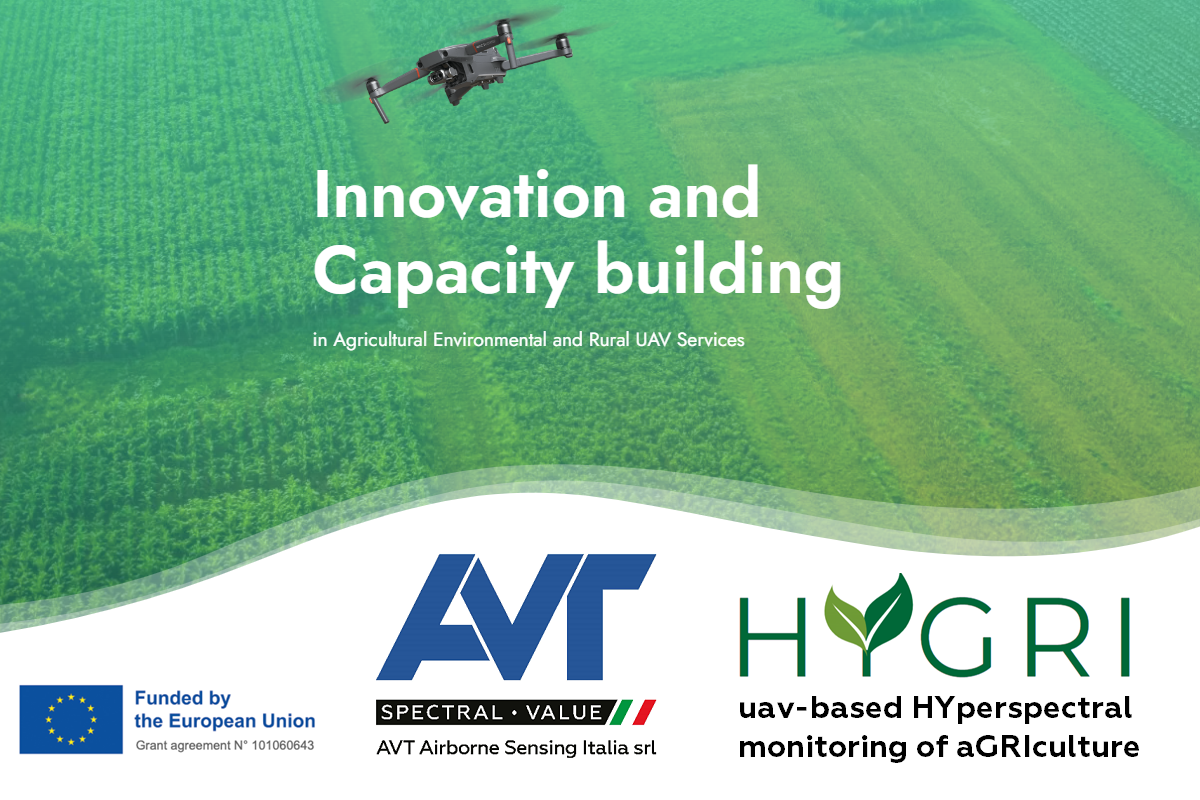
AVT Airborne Sensing Italia srl (AVT-ASI) participates in the ICAERUS project, promoted and funded by the European Union under the HORIZON-CL6-2021-GOVERNANCE-01-2 call, focusing in particular on Cluster 6 (Food, Bioeconomy, Natural Resources and Agriculture). The project aims to promote innovative governance models to support sustainable food systems, environmental monitoring and digital solutions to implement the European Green Deal.
The vision of ICAERUS is to explore the possibilities of drones and provide a comprehensive and interconnected account of their potential and impact as multipurpose vehicles in agriculture, forestry and rural areas in the EU. ICAERUS aims to apply, demonstrate and support the effective, efficient and safe use of drones and to identify the risks and added value associated with their use.
In the 2nd ICAERUS PULL Open Call, AVT Airborne Sensing Italia srl proposed HYGRI (UAV-based HYperspectral Monitoring of Agriculture). The aim of the project is to capture and use hyperspectral images from drones to monitor and detect plant pathogens in fruit trees and to display the information in a user-friendly decision support system.
Thanks to its ability to calculate accurate spectral indices by combining narrow bands in the visible and near-infrared range and using machine learning and deep learning algorithms, HYGRI will detect these plants and support farmers in their daily work, reducing the spread of disease and the need for pruning. It will also benefit our environment and our food, as treatments can be targeted to specific crops.
The pilot area is located in Trentino-Alto Adige and is divided into three different locations:
A vineyard where the results of four different irrigation systems are monitored for both irrigation optimization and the occurrence of associated pathogens;
In an apple orchard, various scenarios with different water availability are tested and monitored on plants with different types of grafting in order to assess their resistance, productivity and vegetative condition.
In a strawberry garden, the physiological and productive conditions of the plants are monitored on soils that have already been used by previous cultivation cycles in order to develop targeted measures to reduce soil leaching.
AVT-ASI's existing expertise forms the basis for the operation of the UAV system and the detection of plants affected by various diseases such as golden discoloration in vineyards, as well as for the analysis of plant condition. However, there is a need for progress to overcome challenges in data acquisition and processing as well as in the selection of the appropriate machine learning method.
The challenges of HYGRI and how they are overcome.
Over the past two years, AVT-ASI has invested in the purchase of Specim's AFX10 hyperspectral camera and in the development of its workflow application, which enables a wide range of analyses in different environments. Pilot projects at AVT-ASI have shown that hyperspectral imaging provides technologically advanced, accurate and reliable data and enables results that cannot be achieved with conventional technologies. However, some challenges have arisen that HYGRI intends to address:
- The quality of UAV hyperspectral images depends strongly on factors that are usually insignificant with multispectral sensors, such as solar radiation, the orientation of the plant rows relative to the azimuth of the sun, the influence of shadows and temporal differences between the stripes;
- The geometric correction of hyperspectral images is subject to uncertainties, as commercial software does not follow such a strict approach (e.g. image triangulation) as in traditional aerial photogrammetry;
- Data processing is fragmented in various software packages or scripts and requires a high level of manual intervention;
- The validation of UAV-based results for the early detection of plant diseases or water stress must be further investigated by additional comparisons with ground-based and multi-temporal measurements.
- The methodology for training machine learning algorithms does not currently allow the approach to be transferred to other diseases or phenomena.
- The data visualization tools for hyperspectral flights do not meet the needs of users without specialist knowledge.
Against this background, the main objective of HYGRI is to make UAV flights more efficient and obtain better image data, to continue the validation of machine learning algorithms using observations from ground-based sensors and to commercialize the services. This goal will be achieved through the following specific objectives (SOs):
SO 1: Optimization of flight planning and hyperspectral image acquisition with drones, taking into account extended settings, parameters and lighting conditions.
Objective 2: Improve the quality of UAV-based hyperspectral images after pre-processing and workflow automation.
Objective 3: Improve the performance of internal machine learning algorithms for early detection of disease-affected plants through rigorous validation by field measurements.
Objective 4: Evaluate the use of the solution for further applications of green space analysis (urban greenery, forestry, other plant diseases).
Objective 5: International marketing of monitoring services and the decision support system (DSS).
Further information: https://icaerus.eu/open-calls-trials/hygri/
In detail: What is ICAERUS?
Drones are an efficient and flexible digital technology that can handle increasingly complex tasks in an environmentally friendly way. However, their widespread use in the agricultural and food sector is limited by costs, knowledge gaps and regulatory and safety-related restrictions.
ICAERUS aims to address these challenges by supporting and demonstrating the effective, efficient and safe use of drones in relevant contexts and identifying the risks and added values associated with their use. This will be achieved through five concrete drone applications representing the main sectoral and societal purposes of drone use in Europe. ICAERUS will also produce several usable outputs with significant positive impact, including the ICAERUS platform.
Learn more: https://icaerus.eu/


